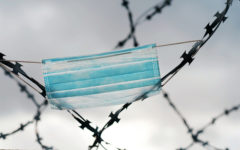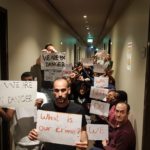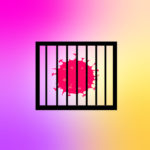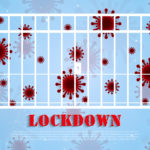If Nonviolent Inmates Aren’t Released for COVID, the Nation Will Pay

Right before the Berejiklian government closed down parliament until mid-September due to the COVID-19 outbreak, it passed a law that allows for the early release of prison inmates on parole based on a number of factors including offence, age, health and vulnerability.
Although, there are questions as to whether these provisions apply to prisoners on remand, who make up a third of NSW’s over 13,000 inmates. Indeed, some of these remandees will go on to be found innocent.
As he was introducing the emergency powers bill, attorney general Mark Speakman made clear that this law was one that the state government hopes it “will never have to use” – which hardly screams early release.
At 3 pm on 29 March, there were 3,966 confirmed cases of the coronavirus in this country, and 16 people had died as a result of the disease. However, the number of cases is set to dramatically increase in the coming weeks due to the way viruses exponentially spread.
So, if an outbreak of COVID-19 occurs at one of Australia’s numerous correctional centres, it’s likely to pass dramatically throughout the facility. And as prison staff will be leaving gaols after every shift, there’s the potential for detention-related infections to spread into the community.
New York’s notorious Rikers Island prison turned up 38 cases of COVID over the week ending on 23 March. And twelve of those affected were staff. While, as of Sunday, Iran – one of the hardest hit countries on the planet – had released 100,000 inmates to prevent greater disease outbreaks.
Inside distancing is impossible
“In gaols, the COVID-19 virus will likely multiply like rampant bacteria in a Petri jar,” said Civil Liberties Australia (CLA) CEO Bill Rowlings. “If the virus gets into a gaol, the closeness of prisoners will mean it’s impossible to contain the spread.”
The Health Department has advised practising the key prevention measure known as social distancing. It includes staying more than 1.5 metres away from other people to ensure that the virus is not passed on. But, as Rowlings points out, this is simply not possible behind bars.
“At mealtimes, and in line-ups for the daily counts or for medicine dispensing, there’s no way people could be 1.5 metres apart. There just isn’t room,” he told Sydney Criminal Lawyers. “Prisoners are among the Australians most vulnerable to a virus.”
Queensland Corrective Services acting deputy commissioner Peter Shaddock recently said pre-COVID that “prisoner health is a matter of public health”. And he went on to explain that “prisoners are some of the most disadvantaged and sickest members of our communities”.
“Another consideration,” Mr Rowlings added, “is that about a third of people in gaol are on remand. That is, they’re not even guilty, but have been charged and are awaiting their day in court. Many of them could, and some should, be out on bail.”
An innocent elderly inmate
Susan Neill-Fraser is a wheelchair-bound elderly inmate locked up for a crime she didn’t commit. The mother-of-two has been incarcerated in a Tasmanian prison since 2009, when she was remanded over the murder of her partner. And she’s now serving a 23 year sentence.
Ms Neill-Fraser’s conviction has always been disputed. And in March last year, 60 minutes presented a report involving an eyewitness recollecting that her male companion brutally murdered Bob Chappell. The young woman had been too scared to reveal this in the past.
Rowlings explained that then Tasmanian DPP Tim Ellis told the jury Neill-Fraser’s DNA was found on a rubber glove presumably used to clean up the crime scene. However, he later apologised, admitting it had been someone else’s DNA.
“No-one believes she would ‘re’-offend, even people who still think she’s guilty,” said CLA president Dr Kristine Klugman. “It’s time for some common sense compassion from the Tasmanian government in the case of this woman who has been sorely tried over the past decade.”
Prevent Aboriginal deaths in custody
The National Aboriginal and Torres Strait Islander Legal Services (NATSILS) released a statement on 23 March, calling on Scott Morrison to release First Nations prisoners from correctional facilities, “as people in prison are extremely vulnerable to COVID-19”.
According to the ABS, there were 42,799 adults being incarcerated in Australian facilities last December, and of these, 11,776 were Indigenous. This means that while First Nations people make up less than 3 percent of the general populace, they account for 29 percent of those inside.
NATSILS is calling for the immediate release of remandees, “women who are victims of family violence and sentenced for lesser offences like fines and public order offences”, young people and those most at risk from COVID-19, like the elderly and people with health conditions.
The national peak body further stated that lockdowns and solitary confinement should be avoided, especially in the case of young people. And they raised concerns about First Nations inmates being completely cut off from friends and family.
Risking overall prevention
Queensland Corrective Services moved to stage two pandemic restrictions on 23 March, meaning all personal visits are prohibited. But, as Rowlings points out, if it decides to impose stage four restrictions it will mean complete lockdown, with no time out of cells.
The long-term civil liberties advocate described these extreme restrictions as “basically locking up prisoners and letting any virus foment”. While the QCS further set out that the stage four scenario is an option of last resort, however it is “prepared for the eventuality”.
Meanwhile the World Health Organisation released a guidance last week on dealing with the coronavirus in prisons, which explains that those detained within these closed environments are particularly vulnerable to the disease and it amplifies the risks for those on the outside.
“The global effort to tackle the spread of disease may fail without proper attention to infection control measures within prisons,” the WHO ominously warned.







